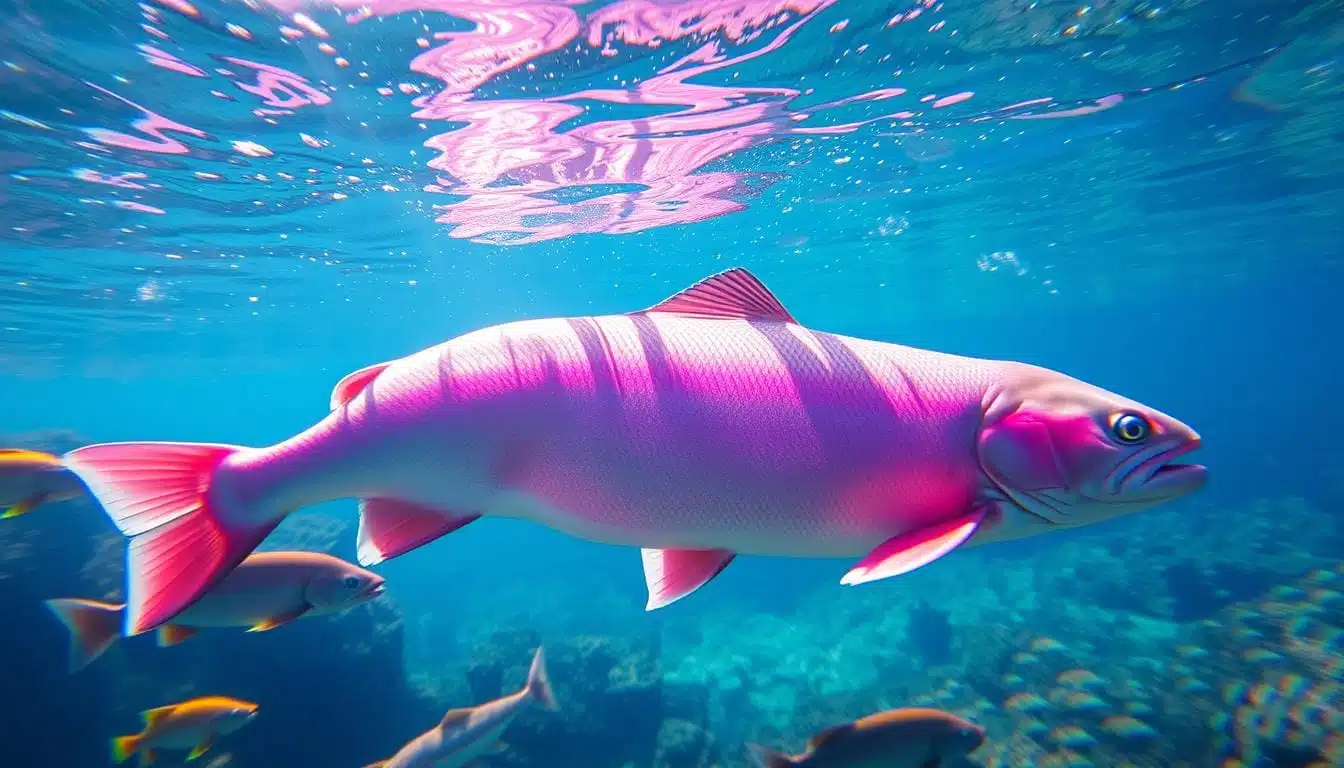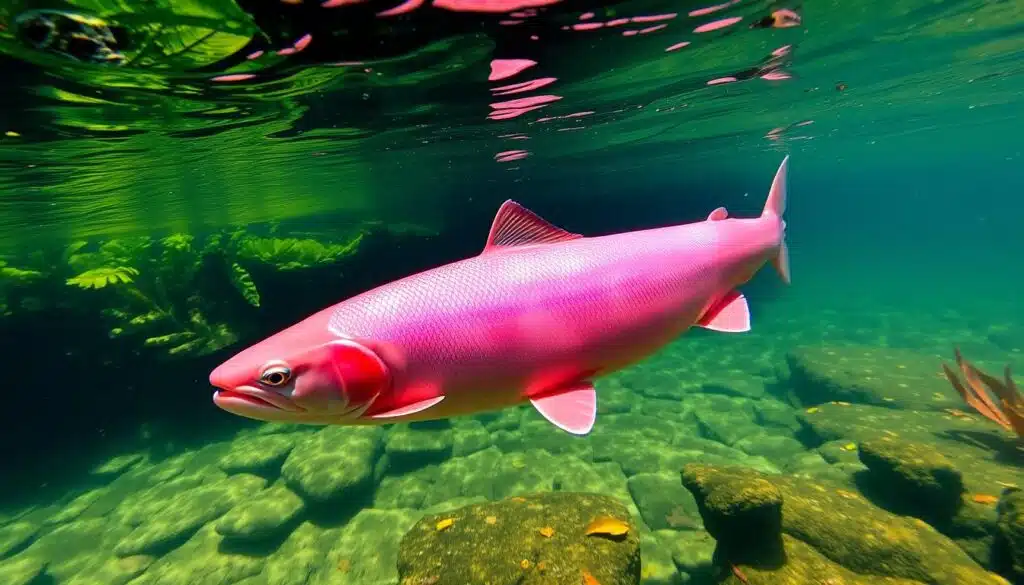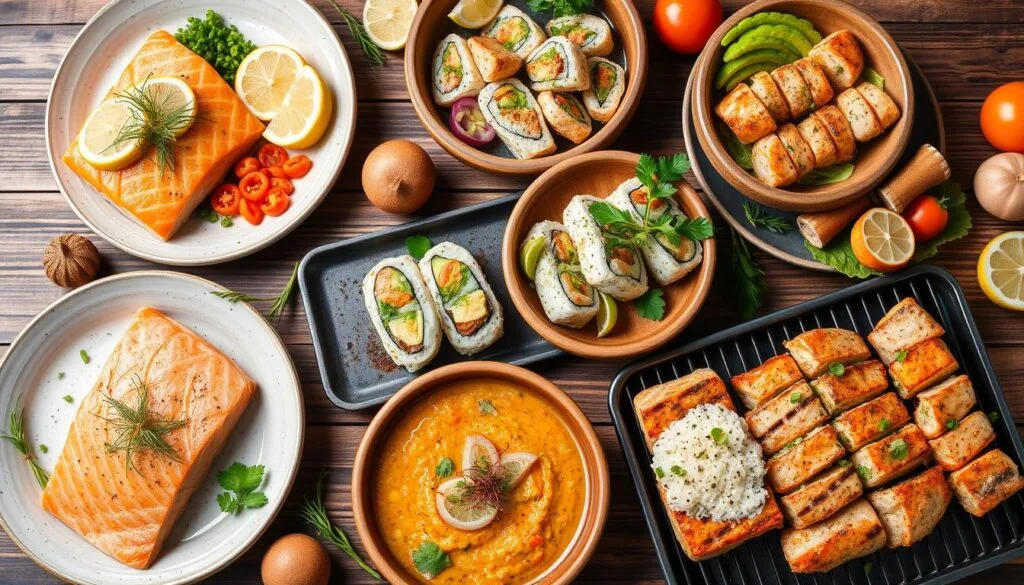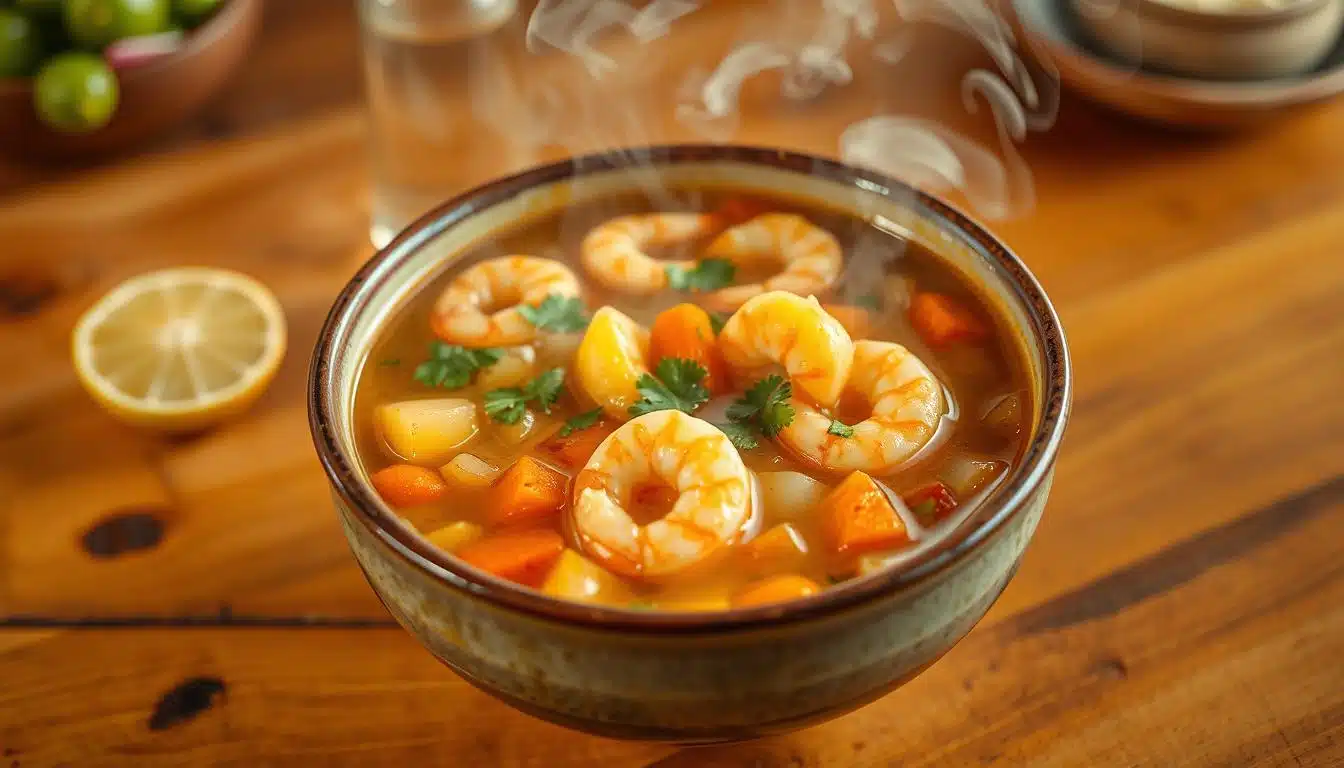Discover the Surprising Diet of the Pink Salmon: Nature’s Perfect Fish

Pink salmon is the smallest Pacific salmon species. It’s packed with nutrients, making it a top pick for healthy meals. Its mild taste and versatility make it a favorite in many dishes.
It’s rich in protein, omega-3 fatty acids, and vitamins. Pink salmon weighs 3.5 to 5 pounds and is 20 to 25 inches long. It’s a great choice for a nutritious meal, offering many recipe options.
Pink salmon is great for those wanting to eat more fish. It offers many health benefits and can be cooked in various ways. It’s perfect for exploring new recipes and finding different ways to enjoy pink salmon.
Table of Contents
Introduction to Pink Salmon: A Pacific Ocean Delicacy
Pink salmon are known for their pink color and rich taste. They are a favorite in the Pacific Ocean. Many enjoy delicious pink salmon meals. To truly appreciate them, we need to know about their home, looks, and life cycle.
Pink salmon live in North America’s coastal waters, from California to Alaska. They are small, weighing 2-3 pounds on average. Their diet includes many marine species. For those who want to cook pink salmon at home, there are many recipes to try.
Pink salmon have big spots on their backs and tail lobes. Male pink salmon have a big hump on their back, called “humpys.” They also have a white mouth and black gum-line, making them unique.
Natural Habitat and Distribution
Pink salmon live in the Pacific Ocean and North America’s coastal waters. They migrate from saltwater to freshwater to spawn.
Physical Characteristics
Pink salmon are pink, have big spots, and a hump on their back.
Lifecycle Overview
Pink salmon have a two-year cycle. They return to spawn in freshwater as two-year-olds. They mature in their second year and return to freshwater in summer or autumn.
What Does Pink Salmon Eat in the Wild?
Pink salmon are meat-eaters that munch on small fish, plankton, and crustaceans. Their diet changes based on where they are and the season. This variety makes their meat both tasty and nutritious.
In the wild, pink salmon snack on herring, anchovies, and krill. They also eat phytoplankton and zooplankton, tiny plants and animals in the water. Eating pink salmon is a smart choice for a healthy meal.
Pink salmon are packed with omega-3 fatty acids, protein, and vitamins and minerals. These nutrients are key for staying healthy. Adding best pink salmon dishes and cooking pink salmon recipes to your meals can boost your health.
Pink salmon’s wild diet is full of nutrients, making them a fantastic choice for a healthy meal. By trying best pink salmon dishes and cooking pink salmon recipes, you can enjoy the health benefits of eating pink salmon nutrition and live a balanced life.
| Nutrient | Amount per serving |
|---|---|
| Omega-3 fatty acids | 1.8g |
| Protein | 35g |
| Vitamin D | 60% of the Daily Value (DV) |
The Amazing Journey from Ocean to Plate
Pink salmon’s path from the ocean to our plates is quite a journey. It involves commercial fishing, sustainability, and quality checks. When we think about que come u pink salmon, we should know how it’s caught and prepared. Fishing methods like trolling, gillnetting, and purse seining are used to catch pink salmon.
For those seeking healthy pink salmon dinner options, it’s good to know that sustainability is key. Catch limits and closed areas help protect pink salmon populations. Also, ensuring freshness and proper handling is vital for safe and healthy eating. By following pink salmon cooking tips, we can make tasty and nutritious meals.
Commercial Fishing Methods
- Trolling: a method where lines are cast into the water and waited for a bite
- Gillnetting: a method where a net is used to catch fish
- Purse seining: a method where a net is used to encircle and catch fish
Understanding pink salmon’s journey from sea to table highlights the value of sustainability and quality. These factors ensure that this tasty and nutritious fish is available for future generations.
Nutritional Profile of Pink Salmon
Pink salmon is packed with nutrients, offering many health benefits. It’s a top source of protein, with 20 grams in every 3-ounce serving. It’s also full of omega-3 fatty acids, which are great for your heart and brain.
When you cook pink salmon, the nutritional value can change. It depends on how you prepare it.
Pink salmon is rich in vitamin D, selenium, and potassium. A 3-ounce serving has 75-85% of the daily selenium value. It also has about 50% of the daily niacin value in a 3-ounce serving.
For tasty pink salmon meals, you can grill, bake, or pan-sear it. These methods can enhance its flavor and nutritional benefits.
Here are some key nutrients in pink salmon:
- Protein: 20 grams per 3-ounce serving
- Omega-3 fatty acids: 564 milligrams per 3-ounce serving
- Vitamin D: 60% of the daily value per 3-ounce serving
- Selenium: 75-85% of the daily value per 3-ounce serving
- Potassium: 10% of the daily value per 3-ounce serving
When making the best pink salmon dishes, think about the nutrients and cooking method. This ensures a healthy and tasty meal.
Essential Health Benefits of Consuming Pink Salmon
Pink salmon is a nutritious food that offers many health benefits. It can help lower the risk of heart disease and cancer. The omega-3 fatty acids in pink salmon also reduce inflammation and improve heart health.
Some of the key health benefits of consuming pink salmon include:
- High content of omega-3 fatty acids, which can help reduce inflammation and improve heart health
- Good source of protein, which is essential for building and repairing tissues in the body
- Rich in vitamins and minerals, such as vitamin D and selenium, which are important for immune function and overall health
When looking for healthy pink salmon dinner options, consider que come u pink salmon. It can be grilled, baked, or sautéed with various ingredients. Adding pink salmon to your diet can bring many health benefits, making it a great choice for a balanced meal plan.
| Nutrient | Amount per 3-ounce serving |
|---|---|
| Omega-3 fatty acids | 1.8 grams |
| Protein | 20 grams |
| Vitamin D | 60% of the Daily Value (DV) |
Selecting the Perfect Pink Salmon
Choosing the right pink salmon is key. Look for freshness, quality, and sustainability. These factors ensure your dishes are not only tasty but also eco-friendly.
To cook pink salmon at home, keep these tips in mind:
- Choose fresh fish with a pleasant smell and firm texture
- Look for certifications such as “Alaska Seafood Marketing Institute” or “Marine Stewardship Council” to ensure sustainability
- Consider the source of the fish, such as wild-caught or farmed, and the fishing methods used
By following these tips, you can make delicious and healthy dishes. Try grilled or baked salmon. With practice, you’ll impress everyone with your cooking skills.

Here is a table summarizing the key factors to consider when selecting pink salmon:
| Factor | Importance | Tips |
|---|---|---|
| Freshness | High | Look for fish with a pleasant smell and firm texture |
| Quality | High | Choose fish with a good balance of fat and protein |
| Sustainability | High | Consider the source of the fish and the fishing methods used |
Popular Cooking Methods for Pink Salmon
Pink salmon is a versatile fish that can be cooked in many ways. It’s important to use gentle heat and avoid overcooking. This keeps it moist and flavorful. Its mild taste and firm texture make it great for many dishes.
Popular methods include grilling, baking, and pan-searing. These techniques help create tasty pink salmon meals. With some basic tips, anyone can make a delicious dish.
Grilling Techniques
Grilling pink salmon adds a smoky flavor. Preheat the grill to medium-high heat. Season the fish with your favorite spices and herbs.
Baking Instructions
Baking pink salmon helps keep it moist. Preheat the oven to 400°F (200°C). Season the fish with your desired spices and herbs.
Pan-Searing Tips
Pan-searing gives pink salmon a crispy texture. Heat a skillet over medium-high heat. Add a small amount of oil. Season the fish and cook for 3-4 minutes per side.
| Cooking Method | Temperature | Cooking Time |
|---|---|---|
| Grilling | Medium-high heat | 4-6 minutes per side |
| Baking | 400°F (200°C) | 12-15 minutes |
| Pan-Searing | Medium-high heat | 3-4 minutes per side |
Seasonal Availability and Best Times to Buy
Pink salmon is available all year, but it’s at its best in summer. This is when you can find the freshest and tastiest pink salmon. Summer is the perfect time to try new recipes and enjoy the nutritional benefits of pink salmon.
Some important dates for salmon seasons include:
- Summer Salmon season usually opens on June 1 for Coho and July 16 for Kings.
- Pinks (Pink Salmon) run every two years during odd years from August 1st to September 15th.
Salmon seasons can change or close due to quotas. It’s important to stay updated. You can also buy frozen or canned pink salmon for convenience and affordability.
When buying pink salmon, think about the season and fishing methods. This ensures you get the best quality. Cooking pink salmon in different ways lets you enjoy its taste and health benefits.
Traditional Pink Salmon Recipes Around the World
Pink salmon is a versatile ingredient used in various cuisines around the world. When considering que come u pink salmon, it’s essential to explore the diverse range of healthy pink salmon dinner options available. From Asian-inspired dishes to European preparations and American classics, there are countless pink salmon recipe ideas to discover.
Asian-Inspired Dishes
In Asia, pink salmon is often used in sushi and sashimi. The delicate flavor and firm texture make it an ideal choice for these dishes. Some popular Asian-inspired recipes include:
- Grilled pink salmon with soy sauce and ginger
- Pink salmon sashimi with wasabi and pickled ginger
- Pink salmon stir-fry with vegetables and noodles
European Preparations
In Europe, pink salmon is often used in fish and chips, fish stews, and other hearty dishes. Some popular European preparations include:
- Pan-seared pink salmon with lemon and herbs
- Pink salmon fish and chips with malt vinegar
- Pink salmon stew with potatoes and vegetables
American Classics
In America, pink salmon is often used in grilled and baked dishes. Some popular American classics include:
- Grilled pink salmon with BBQ sauce and coleslaw
- Baked pink salmon with lemon and dill
- Pink salmon burgers with lettuce and tomato

| Recipe | Ingredients | Cooking Method |
|---|---|---|
| Grilled Pink Salmon | Pink salmon, soy sauce, ginger, garlic | Grilling |
| Pink Salmon Sashimi | Pink salmon, wasabi, pickled ginger, soy sauce | Raw |
| Pink Salmon Stir-Fry | Pink salmon, vegetables, noodles, soy sauce | Stir-frying |
Storage and Preservation Tips
Keeping pink salmon fresh and quality is key. Store it in a sealed container or bag. Always label it with the date and what’s inside. This keeps it fresh longer and prevents contamination.
For home cooking, store pink salmon in the fridge for up to 3 days. Or, freeze it for up to 6 months. Handling the fish gently helps prevent dryness and toughness. Online, you can find many pink salmon recipes to try.
Here are some tips for storing pink salmon:
- Keep it in a sealed container or bag
- Label it with the date and contents
- Store it in the fridge for up to 3 days
- Freeze it for up to 6 months
By following these tips, you can enjoy delicious pink salmon dishes at home. Your fish will stay fresh and of high quality.
Pairing Pink Salmon with Complementary Ingredients
Pink salmon is a versatile ingredient that can be paired with many ingredients. This makes it easy to create tasty pink salmon meals. You can mix it with citrus, herbs, spices, and vegetables to enhance its flavor and texture.
For a quick and tasty meal, try pairing pink salmon with roasted vegetables. Broccolini, green beans, or asparagus are great choices. They complement the salmon’s rich flavor and can be ready in 30 minutes or less. You can also sauté or grill zucchini, broccoli, cucumber, and spinach to bring out their flavors.
Pink salmon also goes well with grains and legumes. A quinoa or farro bed can make a meal more filling and nutritious. Roasted sweet potatoes or cauliflower rice add natural sweetness and texture. These tips help you make healthy and delicious meals with pink salmon.
Wine and Beverage Pairings
A dry white wine like Sauvignon Blanc or Pinot Grigio pairs well with pink salmon. Their crisp acidity and citrus notes complement the salmon’s flavor. For a non-alcoholic choice, lemonade or iced tea can offer a refreshing contrast to the salmon’s richness.
Side Dish Suggestions
Here are some side dish ideas for pink salmon:
- Roasted carrots with Parmesan and garlic
- Spinach salad with ginger dressing
- Grilled asparagus with lemon butter
- Cauliflower rice with herbed pilaf
These side dishes can be made ahead of time and reheated. They’re perfect for a quick and easy meal. With these suggestions and tips, you can make a variety of tasty and healthy meals with pink salmon.
Common Misconceptions About Pink Salmon
Many people think pink salmon is low in fat and calories. But, it’s actually a high-fat fish. This might be because it’s often compared to other fish that are leaner. Yet, eating pink salmon nutrition offers many health benefits. It’s packed with omega-3 fatty acids and protein.
Some think pink salmon is hard to cook. But, it’s actually easy to prepare. You can grill, bake, or pan-sear it. For instance, a simple grilled salmon recipe just needs salt, pepper, lemon juice, and 8-10 minutes per inch of thickness.
Popular best pink salmon dishes include salmon burgers, salads, and stir-fries. These dishes are tasty and nutritious. To cook pink salmon, follow these guidelines:
- Cooking time: 8-10 minutes per inch of thickness for high heat methods, and 10-12 minutes per inch of thickness for moderate heat methods
- Cooking temperature: 425°F for baking, and medium-high heat for pan-searing
- Seasoning: salt, pepper, lemon juice, and herbs like dill and parsley
Knowing the truth about pink salmon and how to cook it opens up many delicious options. Whether you like best pink salmon dishes or cooking pink salmon recipes, eating pink salmon nutrition is a great choice.
| Cooking Method | Cooking Time | Cooking Temperature |
|---|---|---|
| Grilling | 8-10 minutes per inch of thickness | Medium-high heat |
| Baking | 10-12 minutes per inch of thickness | 425°F |
| Pan-searing | 8-10 minutes per inch of thickness | Medium-high heat |
Conclusion: Embracing Pink Salmon in Your Diet
Incorporating pink salmon into your diet is a great choice. It’s not only tasty but also packed with nutrients. It’s full of que come u pink salmon, healthy pink salmon dinner options, and pink salmon recipe ideas.
Pink salmon is rich in omega-3 fatty acids, protein, and vitamins. It’s good for your heart, reduces inflammation, and boosts brain function. This makes it a top choice for a healthy diet.
There are many ways to cook pink salmon, like grilling, baking, or pan-searing. You can make everything from Asian dishes to classic American recipes. Adding pink salmon to your meals can make your diet more nutritious and flavorful.
So, start enjoying pink salmon and discover all its benefits. It’s easy to find, simple to cook, and great for your health. Pink salmon is a fantastic way to improve your diet and overall well-being.





